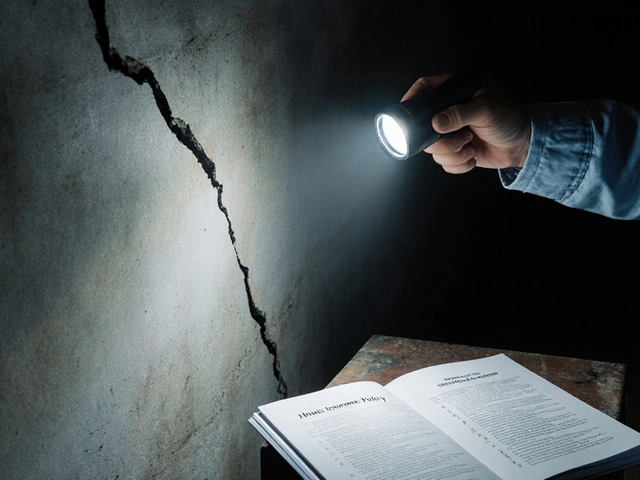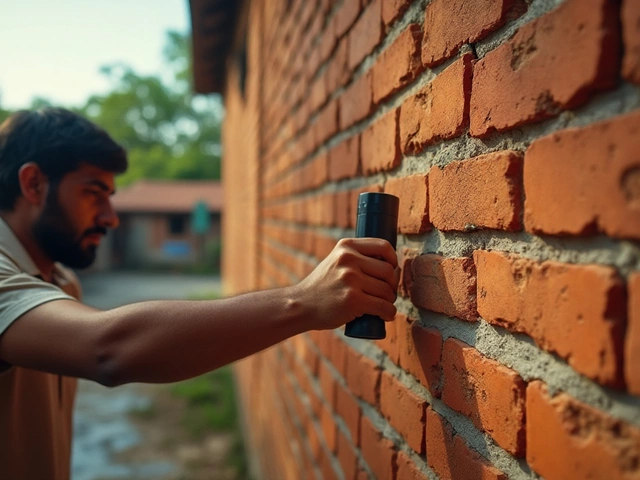When it comes to home maintenance, few things can be more unsettling than discovering a crack in your foundation. This is especially true for horizontal cracks, which can be a sign of serious issues beneath the surface. But before panic sets in, it's important to understand the nature of these cracks and what they mean for your home.
Not all foundation cracks spell disaster. Some are harmless and simply a result of concrete settling over time. But horizontal cracks often require a closer look. Let's delve into what causes these cracks and how homeowners can effectively address them.
- Recognizing Horizontal Foundation Cracks
- Causes Behind the Cracks
- Potential Risks of Ignored Cracks
- Inspection and Diagnosis
- Repair Solutions and Methods
- Prevention Tips for Homeowners
Recognizing Horizontal Foundation Cracks
Delving into the mysteries of our homes, it's often the unseen elements that hold the greatest secrets, and a crack in the foundation is no exception. Identifying a horizontal foundation crack is more than just spotting an unusual line or fracture; it's about understanding what these disturbances indicate. These are typically found along the length of a wall and are different from their vertical counterparts, which run from top to bottom.
Horizontal cracks often emerge in areas where **foundation** walls face outward pressure, especially in homes with basements. The soil surrounding a house can expand and exert force against the foundation during periods of heavy rain or freezing temperatures, much like a fingerprint leaving a mark on a parchment. These tales of unseen pressures are not merely aesthetic blemishes but could signal potential structural damage that jeopardizes the entire structure.
An important aspect to consider in these cases is the material of the foundation. While concrete and block foundations are sturdy, even they can falter under stress. Block foundations, in particular, are susceptible to horizontal *foundation cracks* because the mortar has natural weaknesses that can give under pressure. Curiously, these cracks often tell stories about the water cycles in your region. In areas with extensive rainfall or rapid freeze-thaw cycles, watching for this warning sign is crucial.
Sometimes, evidence of foundation trouble can also be hidden. For example, the existence of mold or unexpected dampness in the interior walls may point toward these cracks allowing water infiltration. Often, early signs of these issues are subtle, such as slight bowing in a foundation wall that might not catch the eye immediately. Because early detection is key, regular basement checks are advisable to catch minor issues before they become significant problems.
“Keeping a wary eye on your **foundation cracks**, especially the horizontal ones, can be akin to reading the first chapter of an unfolding novel. You might find hints of the climax if you're observant enough,” suggests structural engineer Laura Harrow, a respected voice in home safety and repair.
While some **cracks** may appear ominous, not every line spells doom. A trained eye is often needed to separate the benign from the perilous. Regular inspections by professionals can prevent small cracks from escalating into more costly and extensive repairs. Engaging with experts early and often ensures peace of mind and maintains the integrity of the home structure. Taking the time to understand the narrative of *horizontal foundation cracks* can safeguard not just the building, but also the well-being of everyone within its walls.
Causes Behind the Cracks
Understanding the specific reasons behind horizontal foundation cracks is essential for evaluating the potential risks to your home. Unlike vertical cracks, which often arise due to natural settling, horizontal cracks could signal an underlying pressure issue that might escalate into significant structural damage.
One of the primary causes of horizontal cracks is hydrostatic pressure. This occurs when the soil surrounding a foundation becomes overly saturated with water, often due to poor drainage. The intense water pressure against the foundation walls can cause them to bow inward, leading to the formation of cracks. In regions with heavy rainfall or where clay soil is predominant, this issue is particularly common since clay tends to expand considerably when wet.
Another contributing factor is lateral earth pressure, which occurs when soil is compacted around the foundation. When improperly compacted, soil can shift or expand over time, applying substantial force against foundation walls. This is especially true in colder climates where freeze-thaw cycles of the soil add pressure and push against the concrete. Seasonal changes exacerbate this pressure, and homeowners must remain vigilant during cycles of freezing and thawing.
In certain cases, the culprit may be construction or design flaws. Homes that lack proper reinforcement, like steel rebar, might not have the support needed to endure natural soil movements. Older constructions are particularly susceptible, as building codes and materials have evolved drastically over the years. A lack of maintenance or deferred home improvements can let small issues compound into serious defects.
"One of the most important steps in addressing foundation issues is catching them early. Ignoring the signs can lead to more costly repairs down the line," said John Stevens, president of the National Association of Home Builders.
Earthquake activity can also initiate or exacerbate horizontal cracking. New Zealand, being an earthquake-prone region, often experiences such cases where seismic activity displaces the soil and the foundation. This creates lateral shifts that the structure must absorb, sometimes causing cracks if not engineered with these forces in mind.
Finally, tree roots can surprisingly contribute to these cracks as they grow and push against the foundation. Large trees planted too close to homes have root systems that extend far and wide. As they mature, these roots can exert pressure or remove moisture from the surrounding soil, impacting its stability. Homeowners often overlook this factor until visible damage occurs, making regular inspection crucial.
To better understand the impact of different soil types on horizontal foundation cracks, consider the table below:
| Soil Type | Characteristics | Impact on Foundation |
|---|---|---|
| Clay | High water retention, expansive | Increases hydrostatic pressure |
| Sandy | Good drainage, less expansion | Less pressure but prone to erosion |
| Silty | Moderate water retention | Varies, often stable |
Identifying the specific causes of foundation cracks in your home involves inspecting these key elements and factoring them into a comprehensive repair strategy. With professional guidance, you can take proactive measures to secure the safety and longevity of your property.

Potential Risks of Ignored Cracks
Ignoring horizontal foundation cracks can lead to a series of escalating issues for any homeowner. At first glance, a crack might appear as just a small line across your basement wall, almost harmless to the untrained eye. However, these foundation cracks can signify something far more concerning occurring beneath your home. Water infiltration is one of the most immediate threats. With water being one of the most erosive and intrusive elements, it can seep through even the smallest of breaches. Once moisture starts invading the space, it can lead to mold growth, which poses health risks and can severely reduce air quality in living areas.
Structurally, the risks don't end with water. When left unchecked, these cracks can grow. As external pressure from soil and water continues, it might widen these lines, leading to misaligned doors and windows, or worse, buckling walls. Over time, these pressures can contribute to significant structural degradation. Some experts note that if left untreated, these seemingly innocuous cracks could compromise the entire home. A study by the American Society of Civil Engineers outlines that older homes are particularly vulnerable to these issues.
"When you ignore horizontal cracks, you allow the elements to slowly chip away at your home’s integrity," says Joseph L. Burton, a certified structural engineer. "This kind of neglect can lead to catastrophic damage that is costly and sometimes impossible to fully rectify."
Moreover, ignoring foundation issues can have a significant economic impact. Addressing a small crack can be a relatively straightforward affair compared to the expenses incurred from repairing or replacing extensively damaged walls or foundations. Additionally, when it comes time to sell, prospective buyers or inspectors are likely to find these issues, possibly affecting the value or even the saleability of your home.
For those living in climates with extreme temperatures, seasonal changes can exacerbate these problems. Freezing and thawing cycles can cause expansion and contraction in the earth surrounding your home, subsequently applying greater pressure on already compromised walls. These cycles inevitably make existing issues worse, leading to more frequent and severe horizontal cracking.
| Potential Issue | Consequence |
|---|---|
| Water Infiltration | Mold Growth & Health Risks |
| Structural Weakening | Misalignment & Buckling Walls |
| Economic Impact | Reduced Property Value |
Therefore, vigilant inspection and timely repair of these foundation cracks are critical for every homeowner. Understanding the gravity of these risks can encourage a proactive stance towards regular home maintenance checks and professional consultations when necessary. It's less about reacting to visible problems and more about preventing those significant issues from arising in the first place.
Inspection and Diagnosis
Recognizing and diagnosing foundation cracks, particularly horizontal ones, requires a meticulous approach. These cracks often signify an underlying problem that needs immediate attention. Regular visual inspections can reveal much about the health of your home’s foundation. Start by examining the location, size, and direction of the crack. Horizontal cracks, generally, run parallel to the ground and are located about one-third of the way up a foundation wall.
It's crucial to observe any changes over time. Keep notes or take regular photographs to monitor if the crack is widening or extending. Accurate measurement tools may also be beneficial to gauge the width of the cracks, as this can significantly help during professional assessments. Horizontal cracks exceeding 1/4 inch generally suggest serious issues like excessive external pressure from the soil or water, which can lead to structural damage if unaddressed.
Getting a professional evaluation is prudent if horizontal cracks are present. Structural engineers or foundation specialists can provide a comprehensive analysis to determine the severity and cause. They’ll typically begin with a detailed inspection, assessing both the interior and exterior of the house. Some professionals may use advanced tools like laser levels or plumb bobs to check for foundational shift and tilt, providing a more in-depth diagnosis.
According to John Smith, a renowned structural engineer, "Timely inspection and diagnosis of foundation issues not only save money in the long run but ensure the safety and longevity of the home."
Keep in mind that the approach to diagnosing structural damage must be methodical and well-documented. Recording climatic conditions and recent weather events can also offer insights, as extreme wet or dry conditions often contribute to foundational stress. It’s not uncommon for incorrect initial grading or gutter and downspout failure to exacerbate water buildup, increasing hydrostatic pressure against the wall. Surveys around the house may identify these contributing factors, helping in formulating the right repair strategy.

Repair Solutions and Methods
Addressing foundation cracks in your home, especially the horizontal ones, requires a mix of understanding and action. It's not just about covering up the cracks; it's about tackling the root cause and ensuring that your home's structural integrity is not compromised. The process begins with a thorough assessment, often best conducted by a structural engineer who can provide insights into whether it's a superficial concern or an indication of a bigger problem like a shifting foundation.
Once you've pinpointed the cause and severity of the issue, you might choose from several home repair methods. A common technique involves using carbon fiber straps. These are popular because of their ability to provide additional strength without taking up much space. They work by adhering strips across the crack lines, preventing any further widening and reinforcing the wall's durability. The application of these straps typically involves cleaning the surface, applying epoxy, placing the strap, and sealing it for protection.
Another approach is using anchor systems. Anchors are effective for walls that have shifted due to soil pressure. They involve placing heavy-duty steel rods through the foundation wall, which are then anchored into the soil outside. This method not only stops further movement but can also pull the wall back towards its original position. Anchor systems are more invasive, but they offer a permanent solution, making them invaluable for severe cases.
For a more traditional method, injection epoxies and polyurethane resins are often used to fill foundation cracks. These materials seep into the fissures, bonding the concrete back together while blocking moisture. This method is particularly useful for hairline cracks and can help prevent water infiltration, which can lead to mold or further structural issues. It's crucial to clean the area thoroughly and use precisely mixed compounds to ensure maximum effectiveness, often requiring professional expertise for optimal results.
Understanding when to DIY and when to call in the professionals is key. Minor cracks might be something you handle yourself with a bit of knowledge and effort. But for more extensive damage, seeking out a specialized repair contractor with experience in structural damage is advisable. They have access to professional-grade materials and equipment that can ensure a lasting fix. Not to mention, they can offer a warranty on their work, giving you peace of mind.
Regular maintenance and inspections can play a crucial role in early detection and treatment. By keeping an eye on foundation cracks, you can prevent minor issues from becoming major problems. Doing so not only protects your investment but ensures that your home remains a safe haven for years to come.
Prevention Tips for Homeowners
Ensuring your home remains a safe and stable environment is a vital aspect of property ownership. By taking preventative measures, homeowners can significantly reduce the risk of developing unwanted foundation cracks. The first step towards prevention is understanding your home's environment. It's essential to recognize that soil type can play a pivotal role in the health of your foundation. Swelling clay soils, often known as expansive soils, can cause foundations to shift, leading to potential structural damage. To mitigate this, one could consider soil stabilization techniques or installing proper drainage systems to minimize water-induced soil movement.
Regular inspection is another proactive measure. Set time aside every few months to inspect both the interior and exterior of your foundation for signs of distress. While checking, pay particular attention to visible cracks, bowing walls, and any unnatural shifts. It's advisable to document these inspections with photographs and notes. Should you observe new or worsening conditions, it may be time to consult with a structural engineer or foundation specialist.
Maintaining a stable moisture level around your home is equally critical. During dry spells, the soil surrounding your foundation can contract and lead to troublesome gaps. Conversely, heavy rain can cause the soil to swell, placing undue pressure on your walls. To combat this, consider installing a reliable gutter system and positioning downspouts well away from your foundation. This simple step ensures rainwater is diverted from the base of your home, reducing the risk of structural damage over time.
Implementing proper landscaping techniques is an often overlooked prevention strategy. Trees and shrubs are appealing to any property, yet their roots can sometimes interfere with the foundation's stability. Ensure that any larger plants are positioned a safe distance from your home's perimeter. It may also be beneficial to consult with a landscaper who can guide you on appropriate plant choices that are less likely to disrupt the foundation through invasive rooting.
In managing a preventable situation, it's invaluable to heed the sage advice of industry professionals. As one expert once stated,
"Proactive measures, no matter how small, can decrease the probability of encountering costly foundation repairs." — Aaron James, Structural EngineerBeing mindful of these practices not only ensures peace of mind but can also safeguard your property investment for years to come.



Write a comment